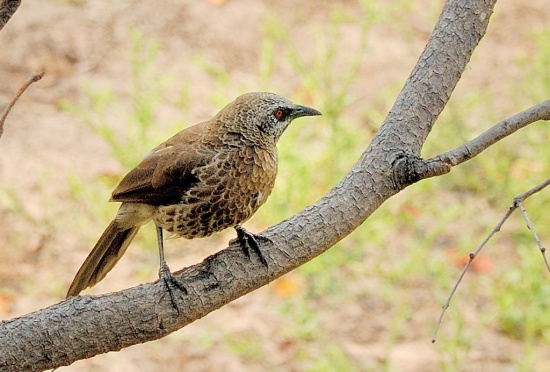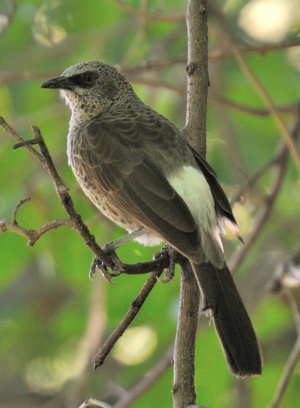Alternative names: Angola Babbbler; Southern White-rumped Babbler; White-rumped Babbler
- Turdoides hartlaubii
Identification
23 - 24cm (9-9½ in). A medium-sized Turdoides-babbler.
- Brownish-grey plumage
- Pale scaling on head to mantle and throat
- White rump
- Short stout black bill
- Orange-red to crimson eye, often with yellow inner ring
Variations
Griseosquamata is paler than the nominate.
Distribution
Africa: Rwanda, Democratic Republic of Congo, Zambia, Tanzania, Angola, Botswana and Namibia.
Common or even abundant in parts of its range.
Taxonomy
May form a superspecies with White-rumped Babbler.
Subspecies
Two subspecies usually accepted[1]:
- T. h. hartlaubii in Rwanda, Democratic Republic of Congo, western and northeast Zambia, southwest Tanzania, Angola and northeastern Namibia
- T. h. griseosquamata in west-central Zambia south to Botswana and extreme western Zimbabwe
The described subspecies ater is considered to be a synonym for the nominate subspecies.
Habitat
Dense scrub between woodlands, gallery woodland, riverine-forest edge, marshy valleys with bushes and tall grass, sometimes reedbeds or papyrus swamp.
Behaviour
Diet
Feeds mainly on invertebrates, foraging mainly on the ground.
Usually seen in pairs or in noisy groups of 5 - 15 birds. Often in mixed flocks with Arrow-marked Babbler.
Breeding
Breeding season from July to October in Angola, March in Tanzania, April to May and October to February in Zambia. Co-operative breeder with a permanent territory. The nest is an untidy bowl made of grasses, dry leaves and thin roots. It's placed about 3m high in a bush, a low tree or among dense tufts of reeds and sedges. Lays 2 - 4 eggs.
Often parasitised by Levaillant's Cuckoo.
Movements
Resident species with some rain-related movements.
References
- Clements, J. F., T. S. Schulenberg, M. J. Iliff, D. Roberson, T. A. Fredericks, B. L. Sullivan, and C. L. Wood. 2017. The eBird/Clements checklist of birds of the world: v2017, with updates to August 2017. Downloaded from http://www.birds.cornell.edu/clementschecklist/download/
- Del Hoyo, J, A Elliott, and D Christie, eds. 2007. Handbook of the Birds of the World. Volume 12: Picathartes to Tits and Chickadees. Barcelona: Lynx Edicions. ISBN 978-8496553422
Recommended Citation
- BirdForum Opus contributors. (2024) Hartlaub's Babbler. In: BirdForum, the forum for wild birds and birding. Retrieved 23 April 2024 from https://www.birdforum.net/opus/Hartlaub%27s_Babbler





